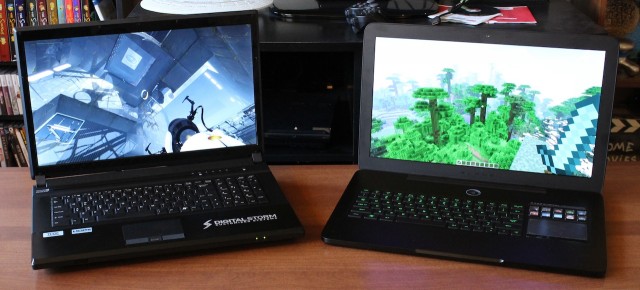 |
| How does the Razer Blade Mk2 (right) stand up to a heavy, powerful gaming laptop? |
Razer's Blade gaming laptop is nothing if not unique. The first version of the attractive-but-expensive laptop launched at a whopping $2,800 and wasn't the fastest laptop on the block. It tried to make up for it with a stylish design and unique touchscreen-turned-trackpad with configurable buttons.
The revised Blade doesn't change this equation much, but it is a nice refinement of what came before. More power-efficient chips from Intel and Nvidia (as well as a redesigned ventilation system) help with heat issues while boosting performance. A slight price drop (to $2,500) helps with the pricing issue.
To help see where the Blade falls in context, we'll be comparing its looks, its build quality, and its performance to a more conventional gaming laptop—Digital Storm was kind enough to send us one of their x17 gaming laptops for comparison. The x17, which is really just a branded version of Clevo's P170EM, is a gaming laptop in the traditional sense: big, bulky, and only relatively "portable."
If you're looking to hang up a big brick like the x17 in favor of something a bit more svelte, does the Blade have the performance to replace one of these monsters?
Micro-review: The DigitalStorm x17 (Clevo P170EM)

The DigitalStorm x17, based on Clevo's P170EM, is a monster in every sense of the word.
| SPECS AT A GLANCE: DIGITALSTORM X17 (CLEVO P170EM) | |
|---|---|
| SCREEN | 1920x1080 17.3" display (127 ppi) |
| OS | Windows 8 64-bit |
| CPU | 2.3GHz Intel Core i7-3610QM (Turbo Boost 3.3GHz) |
| RAM | 16GB 1600MHz DDR3 (upgradeable to 32GB) |
| GPU | AMD Radeon HD 7970M with 2GB of GDDR5 |
| STORAGE | 750GB 7200RPM hard drive |
| NETWORKING | Single-band 802.11n, Bluetooth 3.0, gigabit Ethernet |
| PORTS | 2x USB 3.0, 1x USB 3.0/eSATA, 1x USB 2.0, 1x mini FireWire, DVI, HDMI, DisplayPort, headphone/microphone/line-out/line-in jacks, SD card slot |
| BATTERY | 8-cell 76.96Whr Li-ion |
| SIZE | 16.22 x 10.87 x 1.79-1.65 inches (412 x 276 x 45.4-41.8 mm) |
| WEIGHT | 8.6 lbs (3.9 kg) |
| STARTING PRICE | $1604 |
| PRICE AS CONFIGURED | $1854 (note that the current model at this price has an upgraded Core i7 3630QM CPU, but is otherwise identical) |
| OTHER PERKS | Webcam, Kensington lock slot, backlit keyboard, DVD burner |
This boutique computer from Digital Storm is a traditional gaming laptop, which is to say that it's about as much like a desktop crammed into a laptop's body as is physically possible. This means you get a wide range of accoutrements—a beefy, high-end GPU, a fast quad-core CPU, and plenty of ports and display hookups—but it definitely costs you in terms of size and weight. At 8.6 pounds and 1.78 inches at its thickest point, this thing feels like it should come with a warning about team lifting. It's a laptop made to be carried to LAN parties, but hauling it in a shoulder bag all day would likely result in permanent disability.
This thickness does also enable some desktop-like upgrade options, though: our model came with a 750GB spinning hard drive, but there's a completely separate drive bay that could be used to add an aftermarket SSD to speed the computer up, or another HDD for purposes of configuring a RAID array. The two RAM slots are easily accessible. The GPU is on an MXM daughterboard, making it (at least theoretically) possible to upgrade your GPU in the future. The CPU is socketed, also theoretically allowing for easy drop-in upgrades as long as your new CPU uses the same socket. Dig further and you can find two RAM slots and a slot for an mSATA SSD. Only a few Phillips head screws separate the user from most of these upgrades, bringing a small degree of desktop customizability to something a little more portable.

This is what it looks like when you put a desktop in a laptop's body. Among its many ports, the x17 has DVI, HDMI, and DisplayPort connectors.
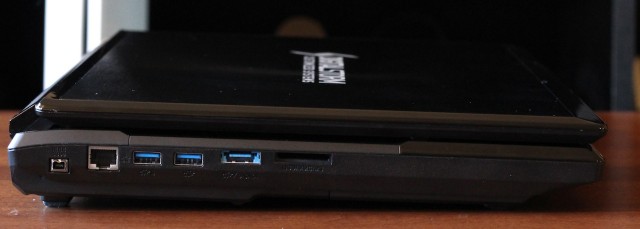
On the left, you've got a mini FireWire port, Ethernet, two USB 3.0 ports, one combo USB 3.0/eSATA port, and a card reader.

On the right, an optical drive, headphone, microphone, line-out and line-in jacks, and a USB 2.0 port.
This desktop-style modularity also brings with it a desktop-style array of ports and extras. Along the sides of the laptop are two USB 3.0 ports, one combo USB 3.0/eSATA port, one USB 2.0 port, an Ethernet jack, a mini Firewire port, a card reader, an optical drive, and separate headphone, microphone, line-in, and line-out jacks. DisplayPort, HDMI, and DVI ports are all located on the back of the laptop, meaning this computer should support up to three external displays—one over DisplayPort and two over HDMI and DVI.
Though we appreciate the laptop's upgradeability, we've got to dock it points for general fit and finish. There's no question that it's very solidly built, and its 17.3-inch 1080p screen is bright and colorful with decent (if not exceptional) viewing angles. The first major point of contention is the backlit keyboard. It's not a chiclet keyboard like we see in so many newer laptops, which isn't a bad thing in and of itself. The problem is that it's often unresponsive—and some keys are worse than others. We suspect this will vary a little from laptop to laptop, but in ours, keys like A and S were especially resistant to input. It makes typing slow and deliberate, and while we've seen many mushy or unsatisfying keyboards over the years we've rarely run into one that actively resisted our efforts to type on it.
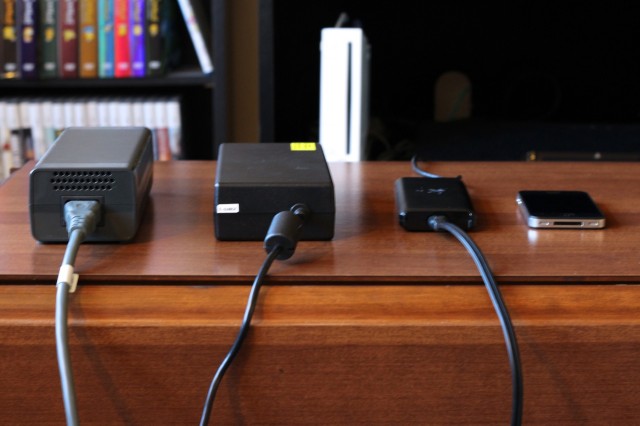
Even the power brick in this thing is huge. From left to right: original Xbox 360 adapter, x17 adapter, Razer Blade adapter, and an iPhone 4S.
We also had intermittent issues with the single-band 802.11n Wi-Fi card in the laptop, which would occasionally drop its connection to (or refuse to connect to) our Netgear WNDR3700 router. This problem persisted in both Windows 7 and Windows 8 using the latest drivers available for the device. It hasn't been a problem for us through the course of innumerable laptop, tablet, and smartphone reviews, so we're inclined to blame either the laptop itself or the Realtek Wi-Fi chip it uses.
Internals and battery life
The benefit to having such a huge laptop is that there's plenty of room for beefy components, and the Digital Storm laptop doesn't disappoint on that front. Our review unit uses a 2.3GHz Intel Core i7-3610QM—it's not the fastest quad-core mobile CPU that Intel makes, but it's still quite zippy. More pertinent to gamers is its AMD Radeon HD 7970M with 2GB of GDDR5 RAM on a 256-bit memory interface, a powerful chip that's just too big to fit in a more conventional laptop.
Our review unit also includes a 7200RPM 750GB spinning hard drive and 16GB of RAM. That hard drive is the machine's biggest bottleneck. While it's easy enough to insert your own aftermarket SSD, it would be nice to see at least an SSD cache in a machine this expensive.
To save power, the laptop makes use of AMD's Enduro graphics switching technology, which is roughly analogous to Nvidia's Optimus. It dynamically switches between the dedicated GPU and Intel's integrated graphics, delivering better battery life when possible and better performance when needed.
The fly in the ointment here is that Enduro isn't quite as mature as Optimus, and it generally isn't as seamless. Using the default settings, the dedicated GPU usually kicked on for games where it was needed, but to bring it online for Portal 2 (just to use an example from our testing suite) we needed to go into the Catalyst driver settings and tell the computer to use the more powerful graphics card. In the case of Minecraft, the system simply wouldn't turn the dedicated graphics chip on no matter what we did, a problem possibly related to that game's use of Java. We'll see this reflected in our benchmarks—the 7970M is quite fast, but it can require tweaking to get the best performance in every situation. If you'd rather use Nvidia's more mature Optimus technology, the x17 can easily be configured with a (cheaper, slightly slower) GeForce GTX 670MX or a (usually faster, more expensive) GeForce GTX 680M when you order it.
The x17 includes a 76.96WHr battery and is rated by Clevo for about six hours of battery life with the switchable graphics enabled. We didn't focus on scientific battery life tests for this overview—for a hardcore gaming laptop, it's not a selling point the way it is in an Ultrabook or even a budget laptop—but realistically you should be able to expect between three and four hours in general usage depending on what you're doing and how bright you light the screen. This isn't fantastic, but it's quite a bit better than these laptops have historically done—two hours or less in a bulky gaming laptop with a beefy dedicated GPU was not uncommon back in the day.
Micro-review: The second-generation Razer Blade
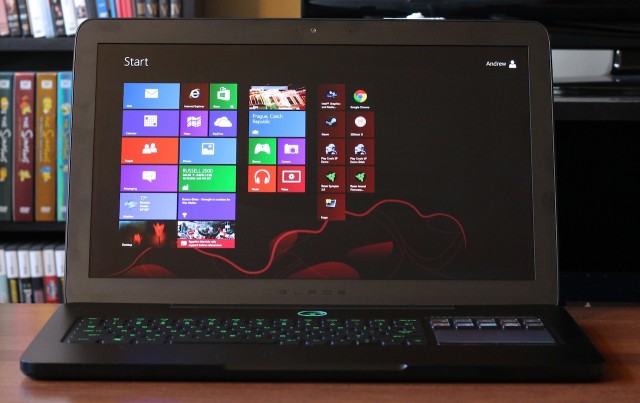 |
| The second-generation Razer Blade. |
| SPECS AT A GLANCE: SECOND-GENERATION RAZER BLADE | |
|---|---|
| SCREEN | 1920x1080 17.3" display (127 ppi) |
| OS | Windows 8 64-bit |
| CPU | 2.2GHz Intel Core i7-3632QM (Turbo Boost 3.2GHz) |
| RAM | 8GB 1600MHz DDR3 (upgradeable to 16GB) |
| GPU | Nvidia GeForce GTX 660M with 2GB of GDDR5 |
| STORAGE | 64GB mSATA SSD cache and 500GB 7200RPM hard drive |
| NETWORKING | Dual-band 802.11n, Bluetooth 4.0, gigabit Ethernet |
| PORTS | 3x USB 3.0, HDMI, headphone jack |
| BATTERY | 60Whr Li-ion |
| SIZE | 16.81 x 10.90 x 0.88 inches (427 x 277 x 22.4 mm) |
| WEIGHT | 6.6 lbs (2.99 kg) |
| STARTING PRICE | $2499.99 |
| PRICE AS CONFIGURED | $2499.99 |
| OTHER PERKS | Webcam, Kensington lock slot, backlit keyboard, customizable touchscreen/trackpad |
The Razer Blade, on the other hand, is what happens when you try to design a gaming laptop rather than just cram as much hardware into it as is humanly possible. It's still a big one—it weighs 6.6 pounds and is 0.88" thick, slightly thinner but about the same weight as the old 17-inch MacBook Pro. That's nearly a full inch thinner and more than two pounds lighter than the x17, and though the Blade isn't anything like a small laptop it makes a huge difference. The x17 feels like something you'd only take off your desk if you were moving or headed to a LAN party, but the Blade could conceivably be used in the place of a more conventional laptop. Both it and the boutique model have 1080p 17.3-inch screens (the display quality in the two is similar, though the Blade's is matte where the Digital Storm model's is glossy) and the two are similar in width and depth. But until I actually stacked them on top of one another, I the Blade felt like a much smaller laptop in every dimension.
The smaller dimensions also means the Blade has a more laptop-like array of ports: three USB 3.0, HDMI, Ethernet, and a headphone jack are all you get. This is pretty good by Ultrabook standards (excepting the lack of a card reader), but it looks particularly anemic next to the battleship that is the Digital Storm laptop. It's also more difficult to upgrade, though not impossible: removing 13 Torx screws from the bottom of the laptop, removing the bottom, and then flipping the motherboard over gives users access to the RAM slots and most of the other components.

The Blade's ports are all on its left side: Ethernet, HDMI, three USB 3.0 ports, and a headphone jack.

The bottom of the laptop can be popped off, and most components can be upgraded (albeit with some difficulty).

The laptop's glowing green logo and keyboard are its main concessions to the often-gaudy "gamer" aesthetic.
Where many gaming laptops (excepting the Digital Storm model, which is relatively restrained) trade in a gaudy aesthetic dominated by ostentatious colored trim and obnoxious glowing LEDs, the Blade's mostly unadorned black aluminum body is sturdy and reserved. There are still some concessions to the "gamer" demographic, namely in the glowing green logo on the lid and the green keyboard backlight. But many gaming laptops look like something you'd buy during a midlife crisis, the Blade is more muted.
Speaking of the keyboard, the Blade's is generally excellent where the Digital Storm model's is inconsistent and unsatisfying. It's a nice, firm chiclet keyboard with good key travel and no bizarre layout issues aside from perhaps its arrow keys—the left and right keys are full-height while the up and down keys are only half-height. It's a bit odd but easy enough to get used to.

The Blade's glowing green keyboard is generally excellent.
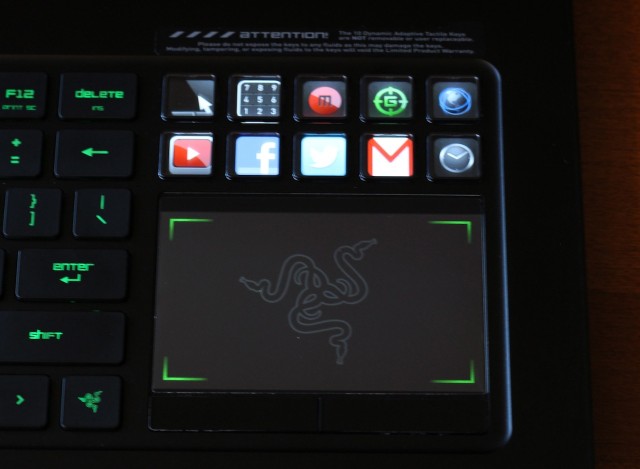
The Blade brings some of the flexibility of a touchscreen to a standard laptop trackpad.
The trackpad is less conventional, and it's one of Razer's biggest talking points—rather than being a clickable plastic or glass surface as in many Ultrabooks and laptops, it's a small multitouch touchscreen to the right of the keyboard that sits above two mouse buttons and 10 configurable keyboard keys. Pressing any of these keys will change the touchscreen from a multitouch trackpad (which supports two-finger scrolling and the Windows 8 multitouch gestures, among other things) into a makeshift Twitter or Gmail client, an extension of the keyboard, or even a stopwatch. For some games, the Razer can even throw up game-specific images and buttons on the touchscreen.
Some of these features are more useful than others. As a social media or e-mail client, it's a bit difficult to touch specific elements on the screen. But as a customizable extension of the keyboard it works quite well—you can remap the keys to any combination of keystrokes, and even use it as an application launcher if you'd like. It's specifically designed to be useful to gamers, who can map its customizable keys to frequently used keyboard shortcuts, something that seems particularly useful for fast-paced real-time strategy games like Starcraft II where every click can count. It's not something anyone really needs, but it's a unique selling point that Razer is right to play up.
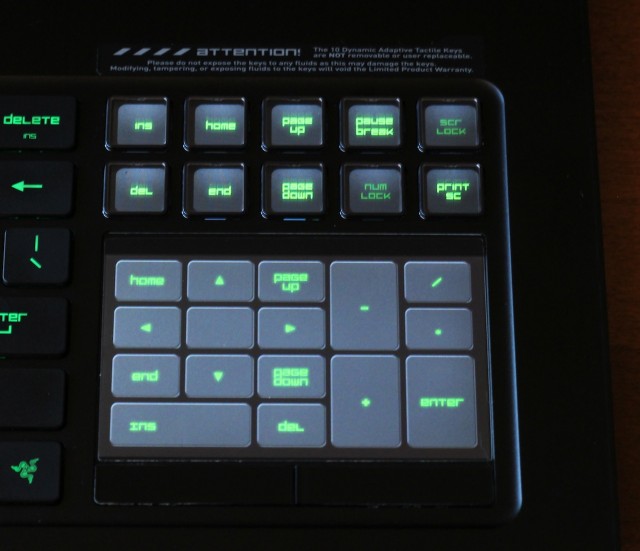
As an extension of the keyboard (both for games and more general tasks), the trackpad and configurable buttons acquit themselves well.

When it comes to checking Twitter or your e-mail, you might be better off taking your phone out of your pocket.
Internals and battery life
Go inside the Blade, and you see where it really compromises compared to the Digital Storm model. It uses a quad-core 2.2GHz Intel Core i7-3632QM that performs very similarly to the slightly faster part in the Digital Storm laptop, though it's worth noting that it's a low-power 35W part rather than the x17's 45W CPU. The CPU performance between the two should be similar, but the Blade opts for a more mid-range Nvidia GeForce GTX 660M as its graphics card. This GPU uses 2GB of GDDR5 RAM but on a slower 128-bit memory interface. It's by no means a bad card and should play most modern games at 1080p with most of the settings turned up. However, as we'll soon see, it usually lags behind the 7970M (and, by extension, the more powerful GTX 670 and 680-series GPUs used in other high-end gaming laptops).
The Blade also uses a 7200RPM spinning hard drive for the bulk of its storage (though in a slightly smaller 500GB capacity), but also supplies a 64GB mSATA SSD from LiteOn for caching—in general use, the Blade usually feels faster than the DigitalStorm model despite the latter's beefier internals.
Finally, another side effect of the Blade's slightly less power-hungry components is that its 60.38WHr battery, despite being smaller than that in the x17, gets better battery life than the larger laptop. Once again, our tests were not extensive, but in standard Web browsing with the screen turned up, the Blade should be capable of around four and a half hours of battery life, an hour or so better than the x17. It won't last you a whole day, but the Blade is at least plausible as a mixed-use laptop.
Benchmarks
Now we're at the fun part: the gaming benchmarks. The Blade is still going to be held back a bit by its thinner profile, but can it deliver "gaming laptop" performance in a package that's more mainstream? Bearing in mind that the CPUs in the two laptops are very similar, we'll be focusing mostly on the difference between the GPUs—that's where the widest (and most pertinent) performance gap is going to be.
We've also included some other benchmarks to provide some context. Dell's XPS 15, here shown in its $1699 configuration, is another high-end laptop similar in many ways to the Blade. It has a nice, clean design, a good keyboard, a great 1080p display, and a quad-core Core i7 processor. The chief differences, aside from size and weight, are the GPU and the price: the XPS 15 we have uses Nvidia's GeForce GT 640M rather than the 660M, but it also costs $800 less than the Blade. We've included both results from that laptop's dedicated graphics card as well as its integrated Intel HD 4000 GPU, which will represent the general gaming performance level of most Ultrabooks.
| NAME | CPU | GRAPHICS | RAM | DRIVER VERSION |
|---|---|---|---|---|
| DigitalStorm x17 | 2.3GHz Intel Core-i7-3610QM | 2GB AMD Radeon HD 7970M | 16GB DDR3 | AMD Catalyst 12.11 beta |
| Razer Blade Mk2 | 2.2GHz Intel Core i7-3632QM | 2GB Nvidia GeForce GTX 660M | 8GB DDR3 | GeForce 306.97 |
| Dell XPS 15 | 2.1GHz Intel Core i7-3612QM | 512MB Nvidia GeForce GT 640M | 8GB DDR3 | GeForce 306.97 |
| Dell XPS 15 | 2.1GHz Intel Core i7-3612QM | Intel HD 4000 | 8GB DDR3 | Driver version 9.17.10.2867 |
We used the latest WHQL-certified drivers for the Nvidia and Intel cards. The Clevo-supplied drivers for the AMD switchable graphics card in the x17 wouldn't allow us to tweak the switchable graphics settings, so we used the latest beta driver from AMD for that laptop.
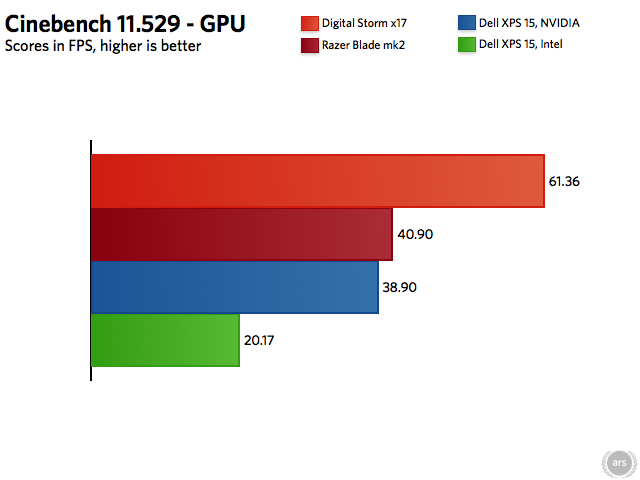

The benchmark to pay the closest attention to in 3DMark is the graphics score—both the final score and the combined score are going to be affected by the physics score, which is more CPU dependent (though not entirely). The graphics score predictably shows the 7970M out in front by quite a bit.
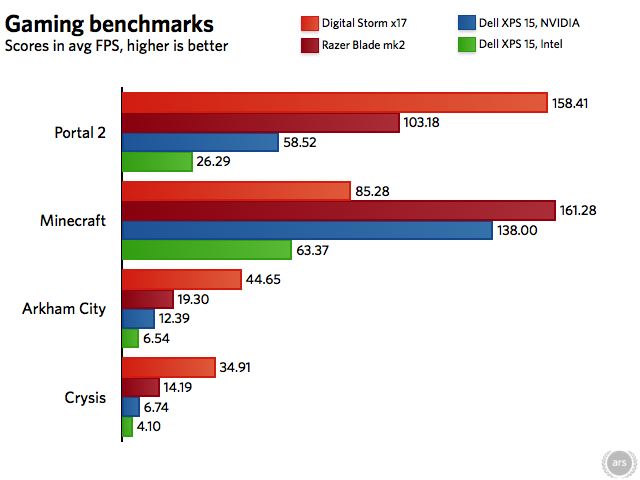
For a full account of our gaming benchmark settings, we're using the same methodology here that we used in our Windows 8 benchmarking article (the same operating system under which all of these benches have been run, incidentally). The short version: we set the games to 1080p, turn all the settings all the way up, turn Vsync off and measure the average framerates with FRAPS.
The x17 typically beats out the Blade by 50 or 60 percent in our actual gaming benchmarks (though the Blade itself is itself about that much faster than the XPS 15 in dedicated graphics mode). The Blade certainly isn't a bad gamer (though it can't play Crysis at 1080p), but its performance is decidedly "laptop-like" where the x17 is capable of more "desktop-like" in its performance characteristics.
The exception to this is in the Minecraft scores, which as we mentioned earlier are being affected by the Digital Storm's AMD-supplied switchable graphics. Nvidia's solution has been refined over several generations and by now really is quite seamless to the user. AMD is getting there but still needs just a little work.
Conclusions

The Blade is much, much thinner and lighter than other gaming laptops, but it will cost you performance and money.
The second-generation Razer Blade is an intriguing proposition. It's a well-designed gaming laptop that at least makes an effort to be portable. But there are three main problems: it's not quite light enough to be a primary laptop for most; its performance, while decent, is a bit too close to more "mainstream" laptops that cost much less; and its price is also much higher than clunkier but better performing boutique PCs like the Digital Storm model.
If the sticker shock doesn't scare you away, there's no denying that the Blade is nicely made. Its construction is good, its screen is nice (though not an IPS panel as we've seen in many Windows Ultrabooks lately), and the performance should be good enough for most games for at least a few years. It just isn't quite the complete package—gamers who insist on the best FPS possible will find cheaper laptops elsewhere, and the same is true of those who want to game but also want something more portable. If the Blade could deliver similar specs in a smaller package—say, 15-inches—I think it would be a big seller for Razer.
DigitalStorm's x17 takes things in another direction, favoring raw performance and upgradeability over design and portability. The end result is a laptop that's a lot like a desktop. But at nearly $2000, a custom-built gaming desktop is still going to give you better bang for the buck if you don't intend to travel.
If you do travel regularly, there's nothing particularly wrong with the big-chunky-gaming-laptop form factor—it's easy to pack up even if you might not want to put it in a shoulder bag and take it to Starbucks. Wireless issues and a buggy, unresponsive keyboard give us qualms about the x17 (and by extension the Clevo P170EM on which it is based), however—if you're looking for a big and powerful gaming laptop we'd probably recommend looking for something with similar specs but a different body.
good
ReplyDeleteI like it!
ReplyDelete